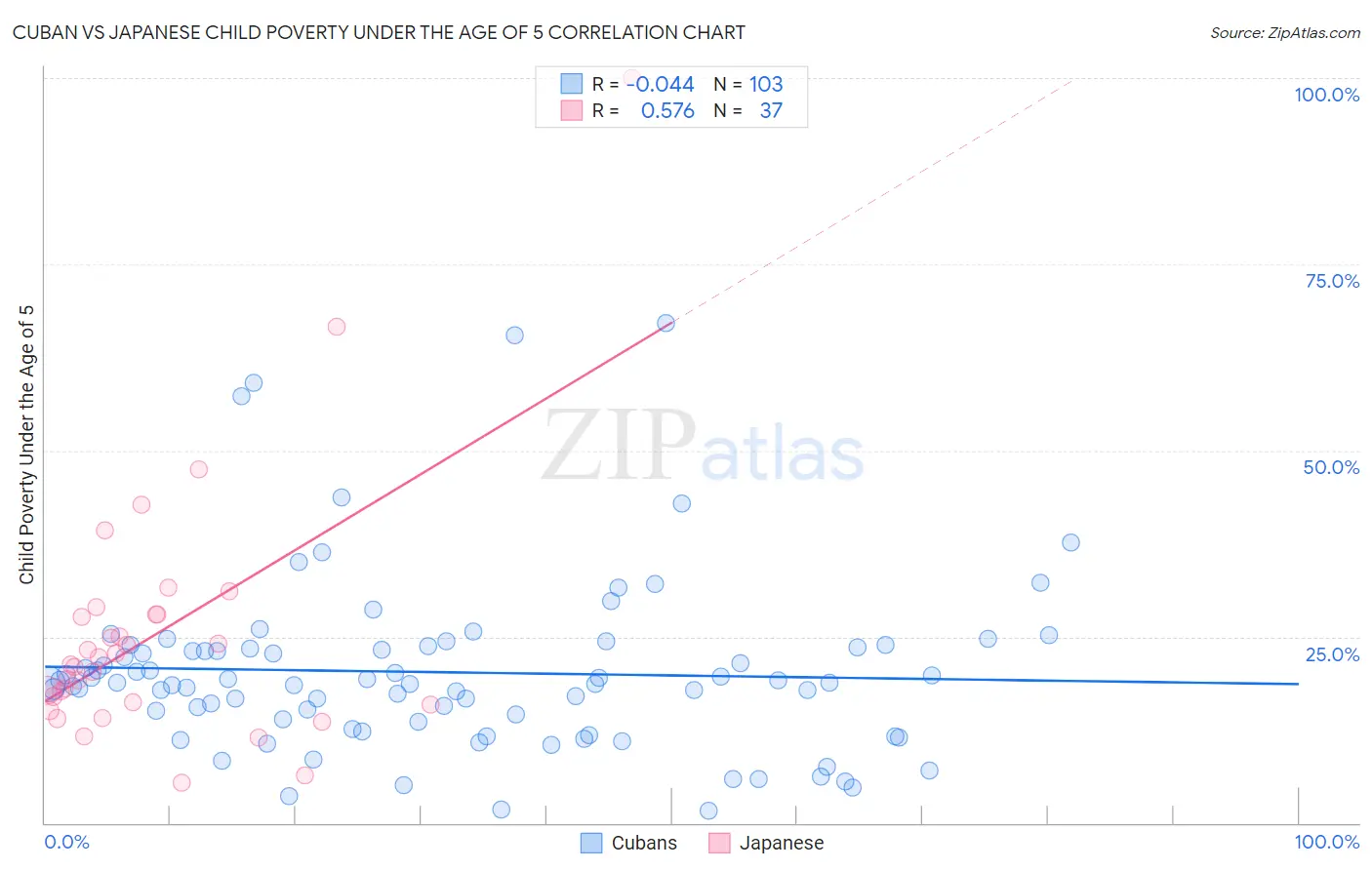Cuban vs Japanese Child Poverty Under the Age of 5
COMPARE
Cuban
Japanese
Child Poverty Under the Age of 5
Child Poverty Under the Age of 5 Comparison
Cubans
Japanese
19.1%
CHILD POVERTY UNDER THE AGE OF 5
1.7/ 100
METRIC RATING
223rd/ 347
METRIC RANK
18.1%
CHILD POVERTY UNDER THE AGE OF 5
13.8/ 100
METRIC RATING
202nd/ 347
METRIC RANK
Cuban vs Japanese Child Poverty Under the Age of 5 Correlation Chart
The statistical analysis conducted on geographies consisting of 429,948,450 people shows no correlation between the proportion of Cubans and poverty level among children under the age of 5 in the United States with a correlation coefficient (R) of -0.044 and weighted average of 19.1%. Similarly, the statistical analysis conducted on geographies consisting of 243,928,105 people shows a substantial positive correlation between the proportion of Japanese and poverty level among children under the age of 5 in the United States with a correlation coefficient (R) of 0.576 and weighted average of 18.1%, a difference of 5.6%.

Child Poverty Under the Age of 5 Correlation Summary
| Measurement | Cuban | Japanese |
| Minimum | 1.6% | 5.4% |
| Maximum | 67.1% | 100.0% |
| Range | 65.5% | 94.6% |
| Mean | 20.2% | 25.2% |
| Median | 18.8% | 21.3% |
| Interquartile 25% (IQ1) | 13.5% | 16.0% |
| Interquartile 75% (IQ3) | 23.6% | 28.1% |
| Interquartile Range (IQR) | 10.1% | 12.0% |
| Standard Deviation (Sample) | 11.7% | 17.1% |
| Standard Deviation (Population) | 11.7% | 16.9% |
Similar Demographics by Child Poverty Under the Age of 5
Demographics Similar to Cubans by Child Poverty Under the Age of 5
In terms of child poverty under the age of 5, the demographic groups most similar to Cubans are Alsatian (19.1%, a difference of 0.020%), Nicaraguan (19.1%, a difference of 0.11%), Nigerian (19.1%, a difference of 0.14%), Immigrants from Eritrea (19.1%, a difference of 0.16%), and Cape Verdean (19.1%, a difference of 0.34%).
| Demographics | Rating | Rank | Child Poverty Under the Age of 5 |
| Hmong | 5.0 /100 | #216 | Tragic 18.5% |
| Immigrants | Africa | 4.6 /100 | #217 | Tragic 18.6% |
| Delaware | 3.4 /100 | #218 | Tragic 18.7% |
| German Russians | 3.0 /100 | #219 | Tragic 18.8% |
| Immigrants | Azores | 2.6 /100 | #220 | Tragic 18.9% |
| Immigrants | Nigeria | 2.1 /100 | #221 | Tragic 19.0% |
| Alsatians | 1.7 /100 | #222 | Tragic 19.1% |
| Cubans | 1.7 /100 | #223 | Tragic 19.1% |
| Nicaraguans | 1.6 /100 | #224 | Tragic 19.1% |
| Nigerians | 1.6 /100 | #225 | Tragic 19.1% |
| Immigrants | Eritrea | 1.5 /100 | #226 | Tragic 19.1% |
| Cape Verdeans | 1.4 /100 | #227 | Tragic 19.1% |
| Immigrants | Sudan | 1.3 /100 | #228 | Tragic 19.2% |
| Ghanaians | 1.2 /100 | #229 | Tragic 19.2% |
| Ecuadorians | 1.2 /100 | #230 | Tragic 19.2% |
Demographics Similar to Japanese by Child Poverty Under the Age of 5
In terms of child poverty under the age of 5, the demographic groups most similar to Japanese are Ugandan (18.0%, a difference of 0.020%), Immigrants from Cambodia (18.1%, a difference of 0.020%), Iraqi (18.0%, a difference of 0.030%), Immigrants from Eastern Africa (18.1%, a difference of 0.080%), and Spaniard (18.1%, a difference of 0.21%).
| Demographics | Rating | Rank | Child Poverty Under the Age of 5 |
| Sierra Leoneans | 24.1 /100 | #195 | Fair 17.7% |
| Immigrants | Portugal | 22.2 /100 | #196 | Fair 17.8% |
| Immigrants | Kenya | 20.0 /100 | #197 | Fair 17.9% |
| Celtics | 18.3 /100 | #198 | Poor 17.9% |
| Hungarians | 18.3 /100 | #199 | Poor 17.9% |
| Iraqis | 14.0 /100 | #200 | Poor 18.0% |
| Ugandans | 13.9 /100 | #201 | Poor 18.0% |
| Japanese | 13.8 /100 | #202 | Poor 18.1% |
| Immigrants | Cambodia | 13.7 /100 | #203 | Poor 18.1% |
| Immigrants | Eastern Africa | 13.4 /100 | #204 | Poor 18.1% |
| Spaniards | 12.8 /100 | #205 | Poor 18.1% |
| Whites/Caucasians | 12.6 /100 | #206 | Poor 18.1% |
| Immigrants | Immigrants | 9.9 /100 | #207 | Tragic 18.2% |
| Scotch-Irish | 9.8 /100 | #208 | Tragic 18.2% |
| Spanish | 9.8 /100 | #209 | Tragic 18.2% |